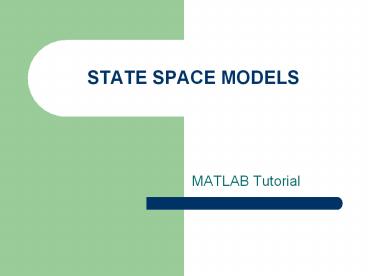STATE SPACE MODELS - PowerPoint PPT Presentation
1 / 19
Title:
STATE SPACE MODELS
Description:
STATE SPACE MODELS MATLAB Tutorial Why State Space Models The state space model represents a physical system as n first order differential equations. – PowerPoint PPT presentation
Number of Views:894
Avg rating:3.0/5.0
Title: STATE SPACE MODELS
1
STATE SPACE MODELS
- MATLAB Tutorial
2
Why State Space Models
- The state space model represents a physical
system as n first order differential
equations. This form is better suited for
computer simulation than an nth order
input-output differential equation.
3
Basics
- Vector matrix format generally is given by
- where y is the output equation, and x is the
state vector
4
PARTS OF A STATE SPACE REPRESENTATION
- State Variables a subset of system variables
which if known at an initial time t0 along with
subsequent inputs are determined for all time
tgtt0 - State Equations n linearly independent first
order differential equations relating the first
derivatives of the state variables to functions
of the state variables and the inputs. - Output equations algebraic equations relating
the state variables to the system outputs.
5
EXAMPLE
- The equation gathered from the free body diagram
is mx" bx' kx - f(t) 0 - Substituting the definitions of the states into
the equation results in - mv' bv kx - f(t) 0
- Solving for v' gives the state equation
- v' (-b/m) v (-k/m) x f(t)/m
- The desired output is for the position, x, so
- y x
6
Cont
- Now the derivatives of the state variables are in
terms of the state variables, the inputs, and
constants. - x' v
- v' (-k/m) x (-b/m) v f(t)/m
- y x
7
PUTTING INTO VECTOR-MATRIX FORM
- Our state vector consists of two variables, x and
v so our vector-matrix will be in the form
8
Explanation
- The first row of A and the first row of B are the
coefficients of the first state equation for x'.
Likewise the second row of A and the second row
of B are the coefficients of the second state
equation for v'. C and D are the coefficients of
the output equation for y.
9
EXACT REPRESENTATION
10
HOW TO INPUT THE STATE SPACE MODEL INTO MATLAB
- In order to enter a state space model into
MATLAB, enter the coefficient matrices A, B, C,
and D into MATLAB. The syntax for defining a
state space model in MATLAB is - statespace ss(A, B, C, D)
- where A, B, C, and D are from the standard
vector-matrix form of a state space model.
11
Example
- For the sake of example, lets take m 2, b 5,
and k 3. - gtgt m 2
- gtgt b 5
- gtgt k 3
- gtgt A 0 1 -k/m -b/m
- gtgt B 0 1/m
- gtgt C 1 0
- gtgt D 0
- gtgt statespace_ss ss(A, B, C, D)
12
Output
- This assigns the state space model under the name
statespace_ss and output the following - a x1 x2 x1 0 1 x2 -1.5 -2.5
13
Cont
- b u1 x1 0 x2 0.5c x1
x2 y1 1 0
14
Cont
- d u1 y1 0 Continuous-time model.
15
EXTRACTING A, B, C, D MATRICES FROM A STATE
SPACE MODEL
- In order to extract the A, B, C, and D matrices
from a previously defined state space model, use
MATLAB's ssdata command. - A, B, C, D ssdata(statespace)
- where statespace is the name of the state
space system.
16
Example
- gtgt A, B, C, D ssdata(statespace_ss)
- The MATLAB output will be
- A
- -2.5000 -0.3750 4.0000 0
17
Cont
- B
- 0.2500 0
- C
- 0 0.5000
- D
- 0
18
STEP RESPONSE USING THE STATE SPACE MODEL
- Once the state space model is entered into MATLAB
it is easy to calculate the response to a step
input. To calculate the response to a unit step
input, use - step(statespace)
- where statespace is the name of the state space
system. - For steps with magnitude other than one,
calculate the step response using - step(u statespace)
- where u is the magnitude of the step and
statespace is the name of the state space system.
19
(No Transcript)































